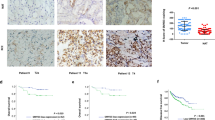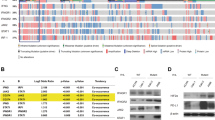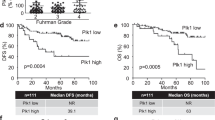Abstract
Activation of hypoxia-inducible factor (HIF) is due to loss of von Hippel–Lindau protein (pVHL) function in most clear cell renal cell carcinomas (ccRCCs). Here we describe a novel pVHL-independent mechanism of HIF regulation and identify nuclear factor (NF)-κB essential modulator (NEMO) as a hitherto unknown oncogenic factor influencing human ccRCC progression. Over 60% of human ccRCCs (n=157) have negative or weak NEMO protein expression by immunohistochemistry. Moderate/strong NEMO protein expression is more frequent in VHL wild-type ccRCCs. We show that NEMO stabilizes HIFα via direct interaction and independently of NF-κB signaling in vitro. NEMO prolongs tumor cell survival via regulation of apoptosis and activation of epithelial-to-mesenchymal transition, facilitating tumor metastasis. Our findings suggest that NEMO-driven HIF activation is involved in progression of ccRCC. Therefore, NEMO may represent a clinically relevant link between NF-κB and the VHL/HIF pathways. Targeting NEMO with specific inhibitors in patients with metastatic ccRCC could be a novel treatment approach in patients with ccRCC expressing functional pVHL.
This is a preview of subscription content, access via your institution
Access options
Subscribe to this journal
Receive 50 print issues and online access
$259.00 per year
only $5.18 per issue
Buy this article
- Purchase on Springer Link
- Instant access to full article PDF
Prices may be subject to local taxes which are calculated during checkout









Similar content being viewed by others
References
Cancer Genome Atlas Research Network. Comprehensive molecular characterization of clear cell renal cell carcinoma. Nature 2013; 499: 43–49.
Sato Y, Yoshizato T, Shiraishi Y, Maekawa S, Okuno Y, Kamura T et al. Integrated molecular analysis of clear-cell renal cell carcinoma. Nat Genet 2013; 45: 860–867.
Shen C, Kaelin WG Jr . The VHL/HIF axis in clear cell renal carcinoma. Semin Cancer Biol 2013; 23: 18–25.
Frew IJ, Krek W . pVHL: a multipurpose adaptor protein. Sci Signal 2008; 1: pe30.
Kaelin WG Jr, Ratcliffe PJ . Oxygen sensing by metazoans: the central role of the HIF hydroxylase pathway. Mol Cell 2008; 30: 393–402.
Staller P, Sulitkova J, Lisztwan J, Moch H, Oakeley EJ, Krek W . Chemokine receptor CXCR4 downregulated by von Hippel-Lindau tumour suppressor pVHL. Nature 2003; 425: 307–311.
Schlesinger-Raab A, Treiber U, Zaak D, Holzel D, Engel J . Metastatic renal cell carcinoma: results of a population-based study with 25 years follow-up. Eur J Cancer 2008; 44: 2485–2495.
Schraml P, Struckmann K, Hatz F, Sonnet S, Kully C, Gasser T et al. VHL mutations and their correlation with tumour cell proliferation, microvessel density, and patient prognosis in clear cell renal cell carcinoma. J Pathol 2002; 196: 186–193.
Young AC, Craven RA, Cohen D, Taylor C, Booth C, Harnden P et al. Analysis of VHL gene alterations and their relationship to clinical parameters in sporadic conventional renal cell carcinoma. Clin Cancer Res 2009; 15: 7582–7592.
Frew IJ, Thoma CR, Georgiev S, Minola A, Hitz M, Montani M et al. pVHL and PTEN tumour suppressor proteins cooperatively suppress kidney cyst formation. EMBO J 2008; 27: 1747–1757.
Rankin EB, Tomaszewski JE, Haase VH . Renal cyst development in mice with conditional inactivation of the von Hippel-Lindau tumor suppressor. Cancer Res 2006; 66: 2576–2583.
Vanharanta S, Shu W, Brenet F, Hakimi AA, Heguy A, Viale A et al. Epigenetic expansion of VHL-HIF signal output drives multiorgan metastasis in renal cancer. Nat Med 2013; 19: 50–56.
Fisher R, Gore M, Larkin J . Current and future systemic treatments for renal cell carcinoma. Semin Cancer Biol 2013; 23: 38–45.
Morais C, Gobe G, Johnson DW, Healy H . Inhibition of nuclear factor kappa B transcription activity drives a synergistic effect of pyrrolidine dithiocarbamate and cisplatin for treatment of renal cell carcinoma. Apoptosis 2010; 15: 412–425.
Oya M, Takayanagi A, Horiguchi A, Mizuno R, Ohtsubo M, Marumo K et al. Increased nuclear factor-kappa B activation is related to the tumor development of renal cell carcinoma. Carcinogenesis 2003; 24: 377–384.
Sourbier C, Danilin S, Lindner V, Steger J, Rothhut S, Meyer N et al. Targeting the nuclear factor-kappaB rescue pathway has promising future in human renal cell carcinoma therapy. Cancer Res 2007; 67: 11668–11676.
Yang H, Minamishima YA, Yan Q, Schlisio S, Ebert BL, Zhang X et al. pVHL acts as an adaptor to promote the inhibitory phosphorylation of the NF-kappaB agonist Card9 by CK2. Mol Cell 2007; 28: 15–27.
An J, Rettig MB . Mechanism of von Hippel-Lindau protein-mediated suppression of nuclear factor kappa B activity. Mol Cell Biol 2005; 25: 7546–7556.
Gilmore TD . Introduction to NF-kappaB: players, pathways, perspectives. Oncogene 2006; 25: 6680–6684.
Rothwarf DM, Zandi E, Natoli G, Karin M . IKK-gamma is an essential regulatory subunit of the IkappaB kinase complex. Nature 1998; 395: 297–300.
Bettermann K, Vucur M, Haybaeck J, Koppe C, Janssen J, Heymann F et al. TAK1 suppresses a NEMO-dependent but NF-kappaB-independent pathway to liver cancer. Cancer Cell 2010; 17: 481–496.
Carvalho G, Fabre C, Braun T, Grosjean J, Ades L, Agou F et al. Inhibition of NEMO, the regulatory subunit of the IKK complex, induces apoptosis in high-risk myelodysplastic syndrome and acute myeloid leukemia. Oncogene 2007; 26: 2299–2307.
Haybaeck J, Zeller N, Wolf MJ, Weber A, Wagner U, Kurrer MO et al. A lymphotoxin-driven pathway to hepatocellular carcinoma. Cancer Cell 2009; 16: 295–308.
Irrinki KM, Mallilankaraman K, Thapa RJ, Chandramoorthy HC, Smith FJ, Jog NR et al. Requirement of FADD, NEMO, and BAX/BAK for aberrant mitochondrial function in tumor necrosis factor alpha-induced necrosis. Mol Cell Biol 2011; 31: 3745–3758.
Legarda-Addison D, Hase H, O'Donnell MA, Ting AT . NEMO/IKKgamma regulates an early NF-kappaB-independent cell-death checkpoint during TNF signaling. Cell Death Differ 2009; 16: 1279–1288.
Maier HJ, Wagner M, Schips TG, Salem HH, Baumann B, Wirth T . Requirement of NEMO/IKKgamma for effective expansion of KRAS-induced precancerous lesions in the pancreas. Oncogene 2013; 32: 2690–2695.
Aigelsreiter A, Haybaeck J, Schauer S, Kiesslich T, Bettermann K, Griessbacher A et al. NEMO expression in human hepatocellular carcinoma and its association with clinical outcome. Hum Pathol 2012; 43: 1012–1019.
Luedde T, Beraza N, Kotsikoris V, van Loo G, Nenci A, De Vos R et al. Deletion of NEMO/IKKgamma in liver parenchymal cells causes steatohepatitis and hepatocellular carcinoma. Cancer Cell 2007; 11: 119–132.
Kim BY, Yang JS, Kwak SY, Zhang XK, Han YH . NEMO stabilizes c-Myc through direct interaction in the nucleus. FEBS Lett 2010; 584: 4524–4530.
Sakamoto K, Hikiba Y, Nakagawa H, Hirata Y, Hayakawa Y, Kinoshita H et al. Promotion of DNA repair by nuclear IKKbeta phosphorylation of ATM in response to genotoxic stimuli. Oncogene 2013; 32: 1854–1862.
Wu ZH, Shi Y, Tibbetts RS, Miyamoto S . Molecular linkage between the kinase ATM and NF-kappaB signaling in response to genotoxic stimuli. Science 2006; 311: 1141–1146.
Yang Y, Xia F, Hermance N, Mabb A, Simonson S, Morrissey S et al. A cytosolic ATM/NEMO/RIP1 complex recruits TAK1 to mediate the NF-kappaB and p38 mitogen-activated protein kinase (MAPK)/MAPK-activated protein 2 responses to DNA damage. Mol Cell Biol 2011; 31: 2774–2786.
Schultz L, Chaux A, Albadine R, Hicks J, Kim JJ, De Marzo AM et al. Immunoexpression status and prognostic value of mTOR and hypoxia-induced pathway members in primary and metastatic clear cell renal cell carcinomas. Am J Surg Pathol 2011; 35: 1549–1556.
Tang SW, Chang WH, Su YC, Chen YC, Lai YH, Wu PT et al. MYC pathway is activated in clear cell renal cell carcinoma and essential for proliferation of clear cell renal cell carcinoma cells. Cancer Lett 2009; 273: 35–43.
Gordan JD, Bertout JA, Hu CJ, Diehl JA, Simon MC . HIF-2alpha promotes hypoxic cell proliferation by enhancing c-myc transcriptional activity. Cancer Cell 2007; 11: 335–347.
Bracken CP, Whitelaw ML, Peet DJ . Activity of hypoxia-inducible factor 2alpha is regulated by association with the NF-kappaB essential modulator. J Biol Chem 2005; 280: 14240–14251.
Dahinden C, Ingold B, Wild P, Boysen G, Luu VD, Montani M et al. Mining tissue microarray data to uncover combinations of biomarker expression patterns that improve intermediate staging and grading of clear cell renal cell cancer. Clin Cancer Res 2010; 16: 88–98.
Beleut M, Zimmermann P, Baudis M, Bruni N, Buhlmann P, Laule O et al. Integrative genome-wide expression profiling identifies three distinct molecular subgroups of renal cell carcinoma with different patient outcome. BMC Cancer 2012; 12: 310.
Maher ER . Genomics and epigenomics of renal cell carcinoma. Semin Cancer Biol 2013; 23: 10–17.
Luu VD, Boysen G, Struckmann K, Casagrande S, von Teichman A, Wild PJ et al. Loss of VHL and hypoxia provokes PAX2 up-regulation in clear cell renal cell carcinoma. Clin Cancer Res 2009; 15: 3297–3304.
Rechsteiner MP, von Teichman A, Nowicka A, Sulser T, Schraml P, Moch H . VHL gene mutations and their effects on hypoxia inducible factor HIFalpha: identification of potential driver and passenger mutations. Cancer Res 2011; 71: 5500–5511.
Pawlowski R, Muhl SM, Sulser T, Krek W, Moch H, Schraml P . Loss of PBRM1 expression is associated with renal cell carcinoma progression. Int J Cancer 2013; 132: E11–E17.
Banning C, Votteler J, Hoffmann D, Koppensteiner H, Warmer M, Reimer R et al. A flow cytometry-based FRET assay to identify and analyse protein-protein interactions in living cells. PLoS One 2010; 5: e9344.
Hanahan D, Weinberg RA . Hallmarks of cancer: the next generation. Cell 2011; 144: 646–674.
Thiery JP, Acloque H, Huang RY, Nieto MA . Epithelial-mesenchymal transitions in development and disease. Cell 2009; 139: 871–890.
Li G, Badin G, Zhao A, Gentil-Perret A, Tostain J, Peoc'h M et al. Prognostic value of CXCR4 expression in patients with clear cell renal cell carcinoma. Histol Histopathol 2013; 28: 1217–1222.
Gassenmaier M, Chen D, Buchner A, Henkel L, Schiemann M, Mack B et al. CXC chemokine receptor 4 is essential for maintenance of renal cell carcinoma-initiating cells and predicts metastasis. Stem Cells 2013; 31: 1467–1476.
Wyler L, Napoli CU, Ingold B, Sulser T, Heikenwalder M, Schraml P et al. Brain metastasis in renal cancer patients: metastatic pattern, tumour-associated macrophages and chemokine/chemoreceptor expression. Br J Cancer 2014; 110: 686–694.
Vogetseder A, Thies S, Ingold B, Roth P, Weller M, Schraml P et al. alphav-Integrin isoform expression in primary human tumors and brain metastases. Int J Cancer 2013; 133: 2362–2371.
Qi H, Ohh M . The von Hippel-Lindau tumor suppressor protein sensitizes renal cell carcinoma cells to tumor necrosis factor-induced cytotoxicity by suppressing the nuclear factor-kappaB-dependent antiapoptotic pathway. Cancer Res 2003; 63: 7076–7080.
Konda R, Sugimura J, Sohma F, Katagiri T, Nakamura Y, Fujioka T . Over expression of hypoxia-inducible protein 2, hypoxia-inducible factor-1alpha and nuclear factor kappaB is putatively involved in acquired renal cyst formation and subsequent tumor transformation in patients with end stage renal failure. J Urol 2008; 180: 481–485.
Meteoglu I, Erdogdu IH, Meydan N, Erkus M, Barutca S . NF-KappaB expression correlates with apoptosis and angiogenesis in clear cell renal cell carcinoma tissues. J Exp Clin Cancer Res 2008; 27: 53.
Li L, Shen C, Nakamura E, Ando K, Signoretti S, Beroukhim R et al. SQSTM1 is a pathogenic target of 5q copy number gains in kidney cancer. Cancer Cell 2013; 24: 738–750.
Hinz M, Scheidereit C . The IkappaB kinase complex in NF-kappaB regulation and beyond. EMBO Rep 2014; 15: 46–61.
Palkowitsch L, Leidner J, Ghosh S, Marienfeld RB . Phosphorylation of serine 68 in the IkappaB kinase (IKK)-binding domain of NEMO interferes with the structure of the IKK complex and tumor necrosis factor-alpha-induced NF-kappaB activity. J Biol Chem 2008; 283: 76–86.
Prajapati S, Gaynor RB . Regulation of Ikappa B kinase (IKK)gamma/NEMO function by IKKbeta -mediated phosphorylation. J Biol Chem 2002; 277: 24331–24339.
Bist P, Leow SC, Phua QH, Shu S, Zhuang Q, Loh WT et al. Annexin-1 interacts with NEMO and RIP1 to constitutively activate IKK complex and NF-kappaB: implication in breast cancer metastasis. Oncogene 2011; 30: 3174–3185.
Kononen J, Bubendorf L, Kallioniemi A, Barlund M, Schraml P, Leighton S et al. Tissue microarrays for high-throughput molecular profiling of tumor specimens. Nat Med 1998; 4: 844–847.
Acknowledgements
We thank M Bieri from University Hospital Zurich for preparing the script and establishing a novel formula for TMA staining intensity measurement, M Storz and S Dettwiler from the tissue biobank, A Fitsche, O Büchi and C Mittmann from the University Hospital Zurich for the excellent technical support, Professor I Frew from the University of Zurich and Dr T O’Connor from the Technical University of Munich for their critical input and reading the manuscript. This work was supported by the Swiss National Science Foundation Grants (3238BO-103145 and Sinergia) to HM; European Research Council (ERC) starting grant, a grant by the Stiftung für experimentelle Biomedizin (Peter-Hans Hofschneider foundation), the pre-clinical comprehensive center (PCCC), the SFB-TR36 and the Else Kröner-Fresenius Foundation to MH. AMN was supported by the NCCR-Kidney.ch.
Author information
Authors and Affiliations
Corresponding authors
Ethics declarations
Competing interests
The authors declare no conflict of interest.
Additional information
Supplementary Information accompanies this paper on the Oncogene website
Supplementary information
Rights and permissions
About this article
Cite this article
Nowicka, A., Häuselmann, I., Borsig, L. et al. A novel pVHL-independent but NEMO-driven pathway in renal cancer promotes HIF stabilization. Oncogene 35, 3125–3138 (2016). https://doi.org/10.1038/onc.2015.400
Received:
Revised:
Accepted:
Published:
Issue Date:
DOI: https://doi.org/10.1038/onc.2015.400
This article is cited by
-
Cell death-related molecules and biomarkers for renal cell carcinoma targeted therapy
Cancer Cell International (2019)



